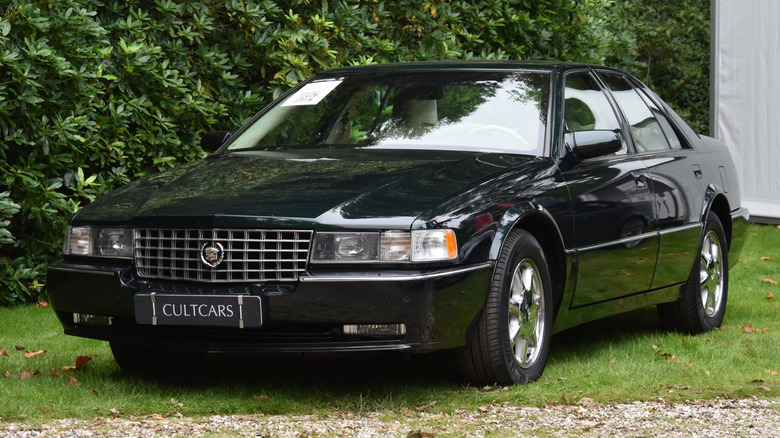
The Cadillac Northstar V8 has, let's call it, a "negative reputation." And why is this? Some of you raised your hands like an A+ student who sits at the front of the class and shouted, "Head gaskets!" Very good, you get a gold star, but it is so much more complicated than that. The real question is why head gaskets tend to blow on early Northstar V8s. The biggest issue, and the one that makes many potential secondhand owners too scared to own one, is that the fine steel threads of the torque-to-yield head bolts on early engines would strip right out of the aluminum block.
Over time, galvanic corrosion would eat away at the threads, and once the bolts were stripped, the heads could pull away from the block. Coolant would then get into the cylinders, and of course, compression would drop. Aside from head bolt problems, early Northstars could also develop an oil leak because the rear main seal wears down faster than it should. As explained by 8020 Automotive, GM didn't press the main seals into the block from 1993 through 1999, but changed the design in 2000 to prevent future leaks.
Speaking of '93 to '99 examples, excessive oil consumption is common thanks to piston rings that build up carbon deposits, ruining their ability to seal against the cylinder wall. New rings fixed this problem in 2000. Oh, and GM still wrestled defeat from the jaws of victory, because from 2000 to 2002, the carbon just built up inside the cylinders instead, leading to overheating. Also, valve cover gaskets can leak and drip oil onto the engine mounts, alternator, A/C compressor, and exhaust manifolds, which are not ideal places to have oil dripping.
 Stoqliq/Shutterstock
Stoqliq/Shutterstock
Trying to find a definitive answer on when GM finally fixed the head bolt issue is like trying to find an objective answer about who's the alien at the end of John Carpenter's "The Thing". At least we know why the Cadillac logo used to have ducks in it. Northstar Performance's Swap/Interchange page timeline shows changes made to the engine over the years, including longer head bolts introduced in 2000. However, according to a service bulletin per Wise Auto Tools (opens a PDF) in late MY2002, GM introduced fixes for the stud issue, raising the thread start height and the block bolt hole depth by 7mm.
While it might seem this negates Northstar Performance's timeline, looking at that same bulletin, we see that it recommends a specific TimeSert kit for fixing 2000-2003 Northstar head bolts, then shows a table with specific bolt dimensions, implying the bolts were the same during that four-year period. According to both the service bulletin and Northstar Performance's timeline, the fine M11x1.5 bolts were replaced in 2004 with coarser M11x2.0 bolts, so it seems that was the year that GM got serious about fixing the Northstar's issues. But, go to Repairpal, and see that 2004 and 2005 Cadillac DeVilles have reports of head bolt problems anyway.
Then, go to the forums, as well as the comments section on Motorweek's review of the 2006 Cadillac STS-V, and people keep referring to 2003 head bolt revisions. It's possible people are conflating the head bolt issue with the cold start engine knock problem, which was, according to the service bulletin, a condition suffered by 2000-2003 Northstars.
 Different_brian/Getty Images
Different_brian/Getty Images
These days, Northstar Performance offers a kit to permanently repair the head studs in your old Northstar and, as The Car Wizard explained, makes the Northstar totally reliable, though the fix is expensive and time-consuming. Can you imagine doing this fix on a Mosler Cadillac Twinstar with two Northstars? Shudder. You could avoid the 4.6-liter Northstar issues entirely by getting one of the two cool factory supercharged Northstar Caddies: The XLR-V or the STS-V. Watch the STS-V Motorweek review, even if for no other reason than to hear John Davis's perfect voice, and you'll notice that the displacement has shrunk from 4.6 to 4.4 liters, yet horsepower ballooned to 469 hp, rivaling the W211 Mercedes-AMG E55 (443 in the XLR-V).
In addition to reducing the bore and decreasing compression in preparation for supercharging, the block is sand-cast instead of die-cast, the deck is semi-closed, the water jacket was improved for better coolant flow, and the head gaskets were changed over to coated multi-layer steel to handle the increased pressure. The best part? Owners report the LC3 is stout with no gasket issues, and STS-Vs are ridiculously cheap. Sure, the XLR-V has once been referred to as "the biggest disappointment in car history," but yesterday's awkward design is today's quirky and unique.
Unfortunately, by the time the niche supercharged 4.4 version came out — and the gasket issues were also largely solved for the N/A 4.6 — the damage was done. Perhaps GM took too long to recognize and address the problem, or maybe the attention shifted to the LS as the performance V8 of choice, thanks to its durability and relative simplicity, but the Northstar was dead by 2011.














